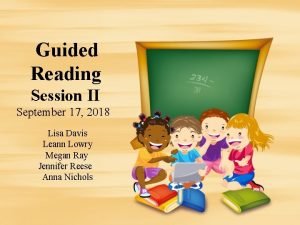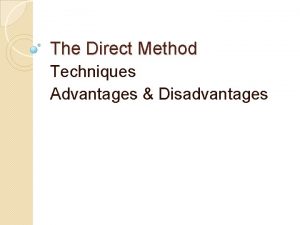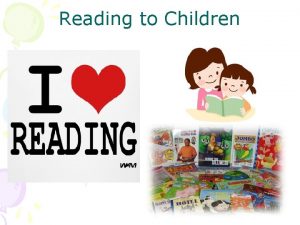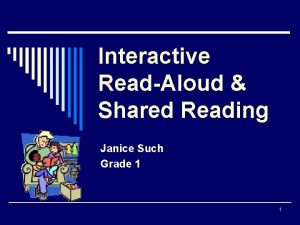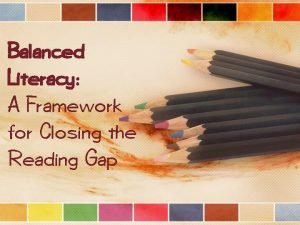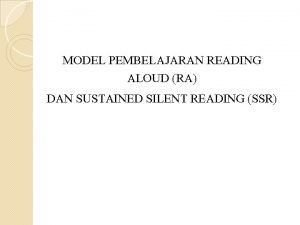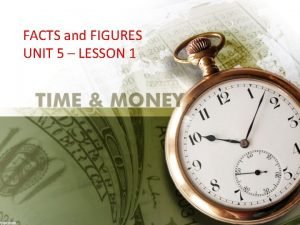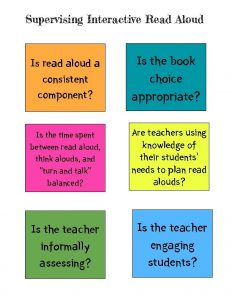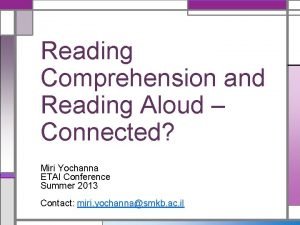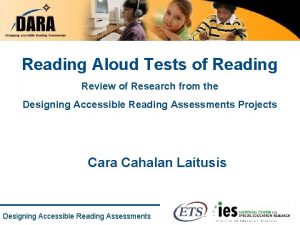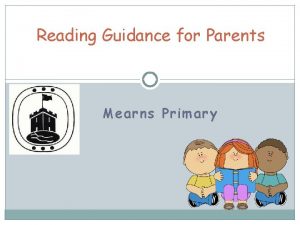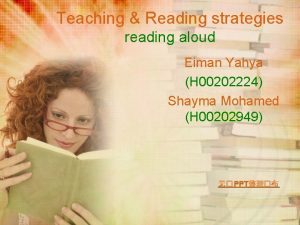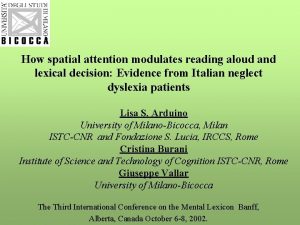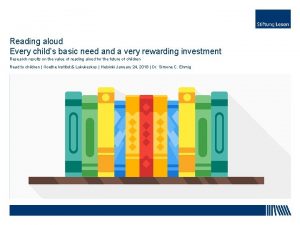Reading Aloud Facts and figures Why Materials What
























- Slides: 24

Reading Aloud • Facts and figures: Why? • Materials: What? and When? • Techniques: How? and Where?

The objectives of this workshop… • Rationale • Tools for you (not just for your students) • This is not about how to teach students to read aloud, but about how to improve YOUR (ie the teacher’s) reading aloud skills

Facts • • • The countries with the highest PISA report scores also have the highest reading scores The more children are read to, the more they read; the better they are read to the better they read. The more they read, the more they know; and the more they know, the smarter they grow.

Principles 1. Humans respond to pleasure. Reading should be a pleasure not a pain. 2. Reading is a skill – the more you do it the better you do it 3. Children who are read to, read. The more they are read to, the more they read; the better they are read to, the better they read.

More reasons … • Vocabulary (books v conversations) • Writing Skills (the more they read the better they write) • Emotional intelligence (levels improve with reading aloud) • Love of literature (your golden opportunity) • Role Modelling • Health

Even more reasons… • • Engender a Love of Reading Build a Close Relationship Inculcate Important Life Skills Help Them Understand the World Around Them • Make Reading a Pleasure

In other words. . reading aloud to children/ adolescents improves… • self-esteem • imagination • emotional intelligence • active listening skills • communication skills • • concentration motivation study skills classroom behaviour • teacher stress levels

"The reasons are … to reassure, to entertain, to inform or explain, to arouse curiosity, and to inspire – create or strengthen a positive attitude about reading regular reading aloud strengthens children’s writing, and speaking skills and thus the entire civilizing process. " Jim Trelease, (The Read Aloud Handbook)

“Reading aloud is a: valuable asset of instruction a capital of which the teacher should make the most profitable use. The teacher, who can do justice to a story, approaches in power the rhapsodist. The pupils will not only listen to her, but will hang breathlessly upon her every word as upon a rhapsodist’s. In this way the teacher will not only win their interest, but infuse into their soul sympathy with what is great and noble, and enthusiastic devotion to high ideals. "

If it’s so good why is it not happening? • Tradition • Training • Time

The good news • Levels are rising • More and more appropriate books are available • The return on investment is high (It’s amazing what 20 minutes a day can do!)

What? . . . Choosing Books • Above expected level v below expected level? • Fiction v Non-fiction? • Their choice or your choice?

Choosing Books • Some are harder to read than others • Some are more/less “PC” • Some are longer/shorter • Do you use the pictures? • Will you ask lots of questions? • What level should I choose?

When and for How long? • 20’ every day minimum • Right after the lunch break and/or perhaps after the morning break • From P 3 to 4 th ESO and beyond …

How and Where? • • In a corner? Sitting at desks? In the school library? In the play ground? • Where are YOU going to be?

Techniques to Prepare the text: - Break the text into chunks - Identify words you do not feel comfortable with and replace them! - Practise the voices - Decide where to use ‘dramatic pauses’ - Decide if/where to ask ‘anticipation questions’ - Practise and vary your reading pace - Decide how to introduce the story e. g….

Dos or Don’ts? - Yes, No, Maybe so 1. 2. 3. 4. 5. 6. 7. 8. 9. Challenge but not overwhelm Stop when asked a question Keep to a strict time plan Read stories you do not enjoy Interpret the story for the audience Read a variety of texts Read ‘Chapter Stories’ Read books with illustrations at any level Sight read

Remember you need to do the same as your students • Read a text out loud ONLY when you have had time to prepare it • Prepare the text to communicate MEANING not WORDS • Read for DRAMATIC EFFECT • Read SLOWLY • Read with and for PLEASURE • VARY the texts – variety is the spice of life!

What You Can Do … • Practise • Persuade • Purchase

Thank you for your attention… Ready to Read?

"The reasons are the same reasons you talk to a child; to reassure, to entertain, to inform or explain, to arouse curiosity, and to inspire and to do it all personally, not impersonally with a machine. All those experiences create or strengthen a positive attitude about reading, and attitude is the foundation stone upon which you build appetites. A secondary reason, and of great importance in an age of rising literacy, is the established fact that regular reading aloud strengthens children’s writing, and speaking skills - and thus the entire civilizing process. " Jim Trelease, (The Read Aloud Handbook)

• Dr. Otto Willman says, reading aloud is a: • "valuable asset of instruction and a capital of which the teacher should make the most profitable use. The teacher, who can do justice to a story, approaches in power the rhapsodist. The pupils will not only listen to her, but will hang breathlessly upon her every word as upon a rhapsodist’s. In this way the teacher will not only win their interest, but infuse into their soul sympathy with what is great and noble, and enthusiastic devotion to high ideals. "

On children reading aloud • “Adults should use materials two years above the listener’s reading ability level, children should read aloud TWO YEARS BELOW their level” (Mary Mc. Elwee)

Should everyone see the text? • NO … that defeats the purpose of reading aloud – there’s no communication , there’s no listening: everyone else can see the text and can silent read it far faster than the reader can. • This also amounts to ineffective learning: the brain doesn’t know whether to listen or to read. • It is perhaps the most humiliating, misused classroom technique currently in use.
 Reading aims
Reading aims What is post reading stage
What is post reading stage Shared reading vs read aloud
Shared reading vs read aloud Direct method merits and demerits
Direct method merits and demerits Shared reading vs read aloud
Shared reading vs read aloud Shared reading vs read aloud
Shared reading vs read aloud Interactive read aloud definition
Interactive read aloud definition Shared reading vs read aloud
Shared reading vs read aloud Sustained silent reading
Sustained silent reading Pictures
Pictures Pre reading while reading and post reading activities
Pre reading while reading and post reading activities Similar and congruent shapes
Similar and congruent shapes Plane shape
Plane shape Plane figures and solid figures
Plane figures and solid figures Amelia and eleanor go for a ride read aloud
Amelia and eleanor go for a ride read aloud The babe and i read aloud
The babe and i read aloud Data raw facts and figures
Data raw facts and figures Facts & figures linda lee
Facts & figures linda lee Facts and figures book
Facts and figures book Fair trade facts and figures
Fair trade facts and figures Tuhh environmental engineering
Tuhh environmental engineering Facts and figures slide
Facts and figures slide Natural materials and man made materials
Natural materials and man made materials Both useful and harmful materials
Both useful and harmful materials Natural man made
Natural man made


